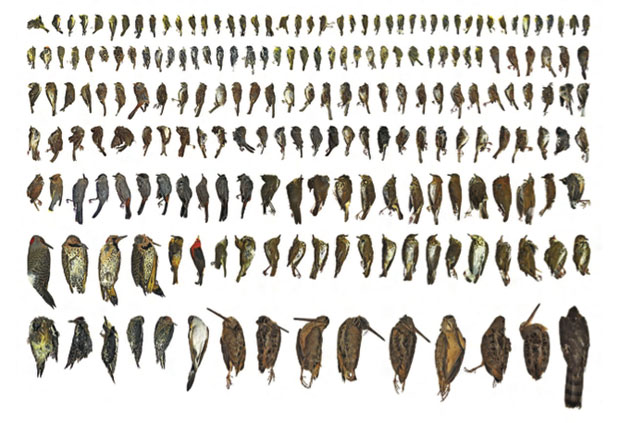
Glass is Air, Windows are Trees, Buildings are Sky
Every year millions of birds die by striking reflective or clear window glass in full flight.
National Geographic’s introductory video.
Two personal stories:
Early this spring, I found a beautiful, but dead, scarlet tanager on wrought iron table next to a client’s plate glass window. It had flown into the glass, and fell down not more than two feet to the table.
Last winter visiting Point of View, we found a dead great blue heron on the ground below the west picture window of the house. The bird had flown into the high second floor window which beautifully reflects the trees and western sky there.
And in Chicago, for example:
“Two days ago, most of the lights were out but one building had its antennas all lit up. There were two beautiful black-billed cuckoos at the base of this building, obviously traveling together and obviously killed by collision after being drawn to these display lights. This is a species in significant decline. These birds traveled all the way from South America to die in a Chicago street.”

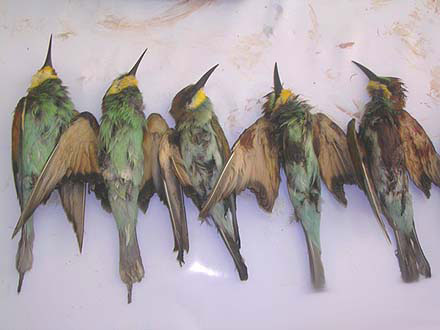
USA = 1 x 10^9
My tanager and heron and the cuckoos in Chicago provide a tiny peek into an appalling situation. In the United States alone, an estimated 100 million to one billion birds perish each year from encounters with buildings, which is 1% – 5% of all birds, a level of mortality which can be biologically significant for already-threatened species.
Bird populations are already in decline from loss of habitat. Buildings, transmission lines, smokestacks, towers, bridges, trains and vehicles all take their toll, having invaded avian airspace relatively recently. Buildings are especially pernicious since some part of all buildings – the glass part – is largely invisible to flying birds regardless of weather or time of day. Interestingly, with buildings, most collisions occur within the first two stories from ground level.
What’s up? Birds are not stupid, but neither are they equipped by nature to understand glass as a solid object. Night-migrating species become confused and lost in the presence of artificially illuminated structures. Light pollution obscures stars required for visual navigation. Glass in buildings kills birds non-selectively, without regard to an individual’s health, intelligence, age, level of adaptation, or size.
Research
One of the earliest researchers to bring a systematic approach to the problem is biologist Dan Klem. He maintains the Birds and Windows site.
The Cornell Lab of Ornithology page has a good summary of the design strategies that work.
Scan this paper published by the Forest Service and you’ll be glad you’re not a bird.
A researcher in Oklahoma has been keeping a near-daily blog of casualties from a one building at Oklahoma State University, with six-month and twelve-month summaries.
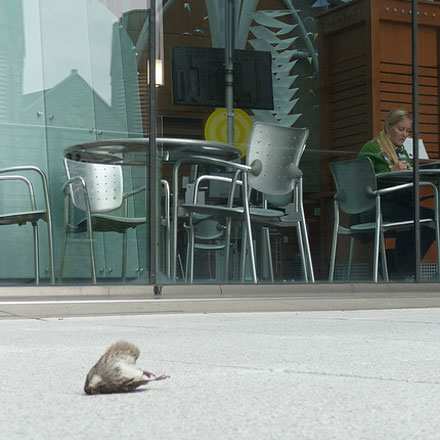
Design Response
For detailed recommendations, download the Bird-Safe Building Guidelines pdf for informative background information coupled with clear, precise design advice. The New York City Audubon Society urban-bird page is here.
The Fatal Light Awareness Program pages provide detailed and practical advice for both commercial and residential structures.
To get a feel for what works and what does not, the guides listed above, and the Birds and Buildings site both have specific case study examples. The Ford Calument Environmental Center by Studio Gang is a great example of bird-centric and very sustainable building design.
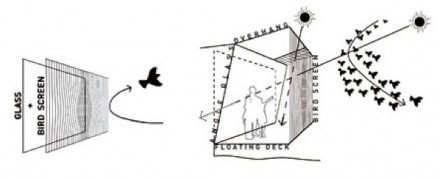
What mother birds must be telling their babies about this project! Don’t. Just. Don’t. Rumor has it the surface of the mirror is covered with UV-reflecting frit – although the architect’s website doesn’t own up to that feature.
Two more blogs with extensive advice are found here, and here.
To summarize: an individual designer’s response is conceptually simple:
- reduce or eliminate reflective glass
- reduce or mitigate transparent glass
- eliminate the beacon effect
- eliminate light pollution
Industry Response
Nanawall is aware.
Lawmakers are proposing ordinances.
Orb-web spiders decorate their webs with structures that reflect ultra-violet light and appear to be protective devices to keep birds from blundering into the web. Ornilux is an award-winning effort by a glass manufacturer leveraging the spider’s stratagem with an applied pattern of UV-reflective film. To birds the pattern is highly visible, to humans, no so much. Ornilux’s North American partner is Roeder.
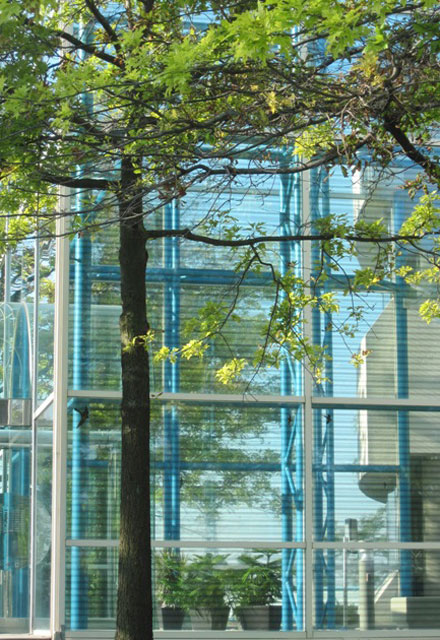
Consumer-grade products are also are appearing on the market with UV-reflective characteristics for use a window stickers.
Also products for architects designing commercial structures.
Update:
American Bird Conservancy article. And a summary of material threat factors from the same organization. And their guide to Bird-Friendly Building Design.
USGBC LEED v4 summary and resource page on bird collision deterrence.
Green Building Alliance page on Bird-Friendly Design.
The US Fish and Wildlife Service’s Reducing Bird Collisions with Building Glass Best Practices paper.
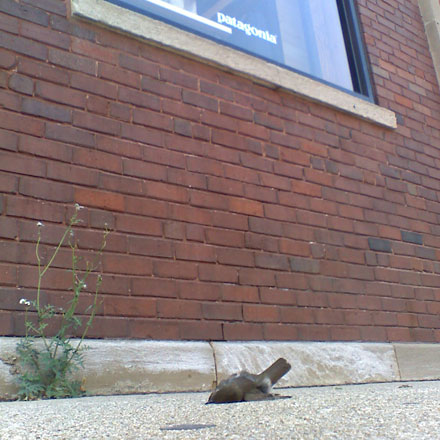
For further reading
Fatal Reflections – Boston.com
How to Reduce the Risk of Bird Strikes
Architectural Record – Calatrava, Studio Gang, and others
Philadelphia Enquirer – Temple University Study
New York Times – Ornilux
A nice overview by Audubon Magazine with a follow-up.

Comments
http://www.topositu.com/2010/11/100-million-birds/
National Geographic has a follow-up on why 5,000 red-wing blackbirds died on New Year’s eve in Arkansas. As it turns out, plain old blunt-force trauma.
The New York Times has an article on the increasing use of bird-safety standards.